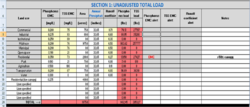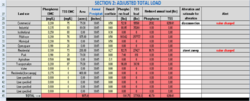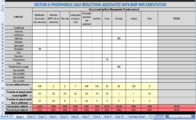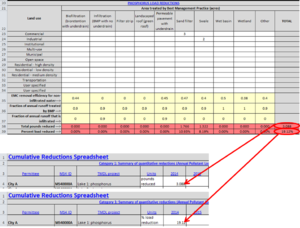
Difference between revisions of "Quick Guide: MPCA Estimator tab"
m |
m |
||
| Line 21: | Line 21: | ||
{{alert|This page has been updated to reflect Version 3.0 of the Estimator|alert-info}} | {{alert|This page has been updated to reflect Version 3.0 of the Estimator|alert-info}} | ||
| − | This page provides a quick guide to using the Estimator. For detailed guidance, [http://stormwater.pca.state.mn.us/index.php/Guidance_and_examples_for_using_the_MPCA_Estimator Link to full guidance on the Estimator]. | + | This page provides a quick guide to using the Minnesota Pollution Control Agency (MPCA) Simple Estimator. For detailed guidance, [http://stormwater.pca.state.mn.us/index.php/Guidance_and_examples_for_using_the_MPCA_Estimator Link to full guidance on the Estimator]. |
The MPCA estimator worksheet presents an easy-to-use calculator to compute the pollutant load reduction for total phosphorus (TP) and total suspended solids (TSS). Results from the estimator can be used in the Cumulative reductions tab of the <span title="the amount of a pollutant from both point and nonpoint sources that a waterbody can receive and still meet water quality standards"> [https://stormwater.pca.state.mn.us/index.php?title=Total_Maximum_Daily_Loads_(TMDLs) '''total maximum daily load''']</span> (TMDL) Annual Report form. | The MPCA estimator worksheet presents an easy-to-use calculator to compute the pollutant load reduction for total phosphorus (TP) and total suspended solids (TSS). Results from the estimator can be used in the Cumulative reductions tab of the <span title="the amount of a pollutant from both point and nonpoint sources that a waterbody can receive and still meet water quality standards"> [https://stormwater.pca.state.mn.us/index.php?title=Total_Maximum_Daily_Loads_(TMDLs) '''total maximum daily load''']</span> (TMDL) Annual Report form. | ||
| Line 31: | Line 31: | ||
*[[Recommendations and guidance for utilizing the MPCA Simple Estimator to meet TMDL permit requirements]] | *[[Recommendations and guidance for utilizing the MPCA Simple Estimator to meet TMDL permit requirements]] | ||
*[[Case study for using the MPCA Simple Estimator to meet TMDL permit requirements]] | *[[Case study for using the MPCA Simple Estimator to meet TMDL permit requirements]] | ||
| + | |||
| + | ==Open the Estimator and read the Information worksheet== | ||
| + | The information worksheet provides some basic information about the Estimator and includes links that may be useful. | ||
==Gather BMP information== | ==Gather BMP information== | ||
| Line 37: | Line 40: | ||
STEP 2: Identify <span title="a stationary and permanent BMP that is designed, constructed and operated to prevent or reduce the discharge of pollutants in stormwater"> '''structural'''</span> and <span title="Stormwater practices that are not permanent, physical devices or structures but that reduce pollutant loading. Examples include street sweeping, pollution prevention, education, impervious surface disconnection, and illicit discharge disconnection."> '''non-structural'''</span> <span title="one of many different structural or non–structural methods used to treat runoff"> '''best management practices'''</span> (BMPs) and identify other activities that affect pollutant loading (e.g. changes in land use). | STEP 2: Identify <span title="a stationary and permanent BMP that is designed, constructed and operated to prevent or reduce the discharge of pollutants in stormwater"> '''structural'''</span> and <span title="Stormwater practices that are not permanent, physical devices or structures but that reduce pollutant loading. Examples include street sweeping, pollution prevention, education, impervious surface disconnection, and illicit discharge disconnection."> '''non-structural'''</span> <span title="one of many different structural or non–structural methods used to treat runoff"> '''best management practices'''</span> (BMPs) and identify other activities that affect pollutant loading (e.g. changes in land use). | ||
| + | |||
| + | STEP 3: Determine the number of worksheets you will need. We recommend using a separate worksheet for the following. | ||
| + | *Each subwatershed in the area of interest | ||
| + | *Contributing drainage areas to BMPs in a <span title="multiple BMPs that work together to remove pollutants utilizing combinations of hydraulic, physical, biological, and chemical methods"> [https://stormwater.pca.state.mn.us/index.php?title=Using_the_treatment_train_approach_to_BMP_selection '''treatment train''']</span> | ||
| + | *Areas that have uniques features compared to other areas within the area of interest | ||
| + | |||
| + | [https://stormwater.pca.state.mn.us/index.php?title=Guidance_and_examples_for_using_the_MPCA_Estimator#Calculation_worksheets Link here for more information] | ||
==Input data to Estimator== | ==Input data to Estimator== | ||
| − | + | The following steps apply to each worksheet being used. | |
| − | + | ||
| − | STEP 4. | + | STEP 4. Enter site information at the top of the worksheet. If entering a TMDL name, select from the dropdown menu. |
| − | |||
| − | |||
| − | |||
| − | |||
| − | + | STEP 5. Calculate and enter the acreage for each applicable land use within the TMDL watershed (Column D, rows 8 through 23). Note a default acreage of 0.000001 is entered for each land use, since an acreage of 0 leads to calculation errors. | |
| − | |||
| + | In the adjacent photo gallery, acreages have been entered for the following land uses. | ||
| + | *Residential with <25% tree canopy coverage | ||
| + | *Residential with >50% tree canopy coverage | ||
| + | *Industrial | ||
| + | *Commercial | ||
| + | *Park | ||
| + | *Transportation | ||
| + | *Mixed (multi-use) | ||
| + | Note that two residential areas have been identified based on tree canopy coverage. | ||
| + | STEP 6. Determine the [http://www.usclimatedata.com/climate/minnesota/united-states/3193 Annual Rainfall] (Column E, rows 8 through 23). The default is 30.65 inches (Minneapolis-St. Paul International airport). | ||
| + | STEP 7. Determine if the default <span title="the average pollutant concentration for a given stormwater event, expressed in units of mass per volume (e.g., mg/L)"> '''event mean concentration'''</span> (EMC; columns B and C, rows 8 through 23) and <span title="The runoff coefficient (C) is a dimensionless coefficient relating the amount of runoff to the amount of precipitation received. It is a larger value for areas with low infiltration and high runoff (pavement, steep gradient), and lower for permeable, well vegetated areas (forest, flat land)."> [https://stormwater.pca.state.mn.us/index.php?title=Runoff_coefficients_for_5_to_10_year_storms '''runoff coefficient''']</span> (column F, rows 8 through 23) are appropriate for your situation | ||
| + | Note the emc was adjusted for one of these residential areas, which triggered a message that the emc had been changed. | ||
| + | Once acreages are entered for land uses, a total load is auto-calculated for the pollutant of concern. The resulting loads for this subwatershed are 1402.45 pounds of phosphorus and 385327 pounds of TSS. | ||
| + | <gallery caption="MIDS Calculator screen shots for unadjusted loads. Click on an image for enlarged view." widths="250px"> | ||
| + | File:Example step 1.png|alt=Screen shot Estimator example|Screen shot showing inputs for land uses and calculation of unadjusted loads | ||
| + | File:Example step 2A.png|alt=Screen shot Estimator example|Screen shot showing adjusted loads | ||
| + | File:Section 3a.png|alt=Screen shot Estimator example|Screen shot showing loads after entering structural BMP data | ||
| + | </gallery> | ||
Revision as of 15:37, 28 March 2020
The MPCA Simple estimator is an Excel-based tool that utilizes the Simple Method to estimate total suspended solid and/or total phosphorus loads and load reductions associated with implementation of best management practices (BMPs). The spreadsheet includes the following features.
|
This page provides a quick guide to using the Minnesota Pollution Control Agency (MPCA) Simple Estimator. For detailed guidance, Link to full guidance on the Estimator.
The MPCA estimator worksheet presents an easy-to-use calculator to compute the pollutant load reduction for total phosphorus (TP) and total suspended solids (TSS). Results from the estimator can be used in the Cumulative reductions tab of the total maximum daily load (TMDL) Annual Report form.
Useful links
- Download updated MPCA Estimator here: File:MPCA simple estimator version 3.0.xlsx
- Link to full guidance on the TMDL Form
- Link to full guidance on the Estimator
- Recommendations and guidance for utilizing the MPCA Simple Estimator to meet TMDL permit requirements
- Case study for using the MPCA Simple Estimator to meet TMDL permit requirements
Open the Estimator and read the Information worksheet
The information worksheet provides some basic information about the Estimator and includes links that may be useful.
Gather BMP information
STEP 1: Define the boundaries of your area.
STEP 2: Identify structural and non-structural best management practices (BMPs) and identify other activities that affect pollutant loading (e.g. changes in land use).
STEP 3: Determine the number of worksheets you will need. We recommend using a separate worksheet for the following.
- Each subwatershed in the area of interest
- Contributing drainage areas to BMPs in a treatment train
- Areas that have uniques features compared to other areas within the area of interest
Link here for more information
Input data to Estimator
The following steps apply to each worksheet being used.
STEP 4. Enter site information at the top of the worksheet. If entering a TMDL name, select from the dropdown menu.
STEP 5. Calculate and enter the acreage for each applicable land use within the TMDL watershed (Column D, rows 8 through 23). Note a default acreage of 0.000001 is entered for each land use, since an acreage of 0 leads to calculation errors.
In the adjacent photo gallery, acreages have been entered for the following land uses.
- Residential with <25% tree canopy coverage
- Residential with >50% tree canopy coverage
- Industrial
- Commercial
- Park
- Transportation
- Mixed (multi-use)
Note that two residential areas have been identified based on tree canopy coverage.
STEP 6. Determine the Annual Rainfall (Column E, rows 8 through 23). The default is 30.65 inches (Minneapolis-St. Paul International airport).
STEP 7. Determine if the default event mean concentration (EMC; columns B and C, rows 8 through 23) and runoff coefficient (column F, rows 8 through 23) are appropriate for your situation
Note the emc was adjusted for one of these residential areas, which triggered a message that the emc had been changed.
Once acreages are entered for land uses, a total load is auto-calculated for the pollutant of concern. The resulting loads for this subwatershed are 1402.45 pounds of phosphorus and 385327 pounds of TSS.
- MIDS Calculator screen shots for unadjusted loads. Click on an image for enlarged view.
STEP 7. Choose the calculator that matches the pollutant for the TMDL you chose. The screenshot below shows the appropriate calculator for a Phosphorus TMDL. Enter the acreage treated by each BMP type for each appropriate land use within the appropriate reductions calculator. The acreage is a cumulative acreage for all BMPs of the same type.
Once acreages are entered, total pounds (for TP in this example) and percent load reduced are auto-calculated. In the example below, the permittee operates three acres of sand filters (could be multiple sand filters totaling 3 acres) in commercial areas and two acres of swales (could be multiple swales totaling 2 acres) in industrial areas. The total pounds of TP reduced are 3.088 and the total TP reduced is 19.12 percent. As a check, the worksheet will generate an error message if the acreages entered exceed total land use acreage.
STEP 8. Input the calculated reductions (choose pounds reduced or percent load reduced) to Category 1 in the Cumulative Reductions tab for that reporting year and TMDL.



